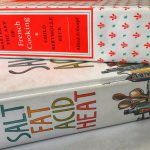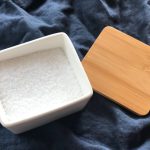What I Learned From Reading Samin Nosrat’s Salt, Fat, Acid, Heat

I, like many women of my generation, know all too well how difficult it is to be a professional anything. If you are too soft, you’re a push over. If you are too hard, you’re a b**ch. It is hard to maintain the balance between the two extremes, and I can only imagine how difficult that is in the culinary world. But, Nosrat is able to do just that. She is authoritative in her knowledge on the subject of food and cooking, because she took the initiative to find the answers, but she is also easily excited at the prospect of a good meal. She reminds me of Julia (Child, of course). I mean, even the (full) title of her book sounds a lot like Julia’s Mastering the Art of French Cooking.

I studied Salt, Fat, Acid, Heat like I would a text book. I made notes. I had epiphanies. I bought a charcoal grill. Reading about where Nosrat got her start made me want to return to San Francisco so I can have the experience that is Chez Panisse. I re-watched her Netflix show before first attempting her recipes for Buttermilk-Marinated Roast Chicken, and Persian-ish Rice, also known as Tahdig (recipes and my results coming soon!).
Long story short, I became obsessed. Here are 10 takeaways I learned from reading Salt, Fat, Acid, Heat.
#1 Get and Use a Salt Bowl
“Get rid of the shaker, dump the salt in a bowl, and start using your fingers to season your food.”

Okay, so technically, this is probably more of a box, since there is a lid, but you get the picture.
Before I bought my salt bowl (box, whatever), which I found on Amazon, I just left my large box of Morton Kosher Salt sitting on my counter. I would dump out the desired amount into my hand, but a lot of times, there would be too much, which I would waste since it was too hard to get back in the container, or there wasn’t enough, so I’d have to go back for more.
The bowl definitely makes portioning the salt way easier. I use it for everything now.
#2 White People Don’t Season Things Right
They’ve been telling us this for a while. Just look on Twitter.
Say what you want, but pretty much every other culture is laughing at us and our bland chicken, potato salad, mac and cheese….and the list goes on. Interestingly, in the South, where I’ve lived my entire life, there are exceptions to this general rule, but that probably has a lot to do with the cultural influences found in traditional Southern food. HINT: that culture ain’t from the Anglo-Saxons.
Unfortunately, I think this stereotype has merit. I’ve known people who travel to different areas of these great United States with hot sauce packets (‘in my bag, swag” – Beyonce, Formation) and Tony Chachere’s because they are terrified of ordering something in a restaurant in Indiana.
Nosrat doesn’t come right out and insult white people. She’s too nice for that. But what she does do is talk about how salt amplifies and acid balances flavor. She tells the story of her first Thanksgiving in America and how a little sour cream would have done wonders for the mashed potatoes. I tried it. She’s right.
#3 You Don’t Have to Add Pepper Just Because You Add Salt
The primary role that salt plays in cooking is to amplify flavor.
Pepper, on the other hand, is a spice, and proper spice usage is primarily guided by geography and tradition.
Simply put, salt is a mineral, and pepper is a spice.

Almost all recipes I’ve come across, either online or in cookbooks end the list of ingredients with: salt and pepper to taste. But it turns out, you don’t necessarily need pepper. Traditionally, French and Italian food has abundant amounts of pepper, but not so in Turkey, Morrocco, Thailand and the Middle East.
Interesting, right?
#4 “…time can do some of the work of good cooking even better than the oven can”
“You have to bring meat up to room temperature. You have to pull it out from the fridge and let it sit on the counter for an hour or longer depending on the size. When you go straight from the fridge into the oven, it will never cook evenly. The skin of the chicken will rip. The outside will get burnt and overly dry before the inside can even cook. That’s why a lot of Thanksgiving turkeys come out raw,”
Nosrat explains the importance of letting uncooked meat come to room temperature before cooking it on Episode 4: Heat, of her Netflix series.
Nuff said.
#5 Why I like Beer with a Fatty Steak More Than Red Wine
Going back to acid balancing flavors, I have to confess, a lot of times I use A-1 Steak Sauce on my steak. I just love the flavor, even though it’s not the most refined thing to do. But, I only need it for fattier pieces of meat, like ribeyes. I also prefer a lager (think Miller High Life) or a light pilsner with a fatty steak even more so than red wine. Shoot me, ok.
I used to wonder why this is. I mean, red wine is my alcohol of choice, and if I am at a nice steakhouse, I usually order the filet mignon, and with that, hold the A-1 and bring on the heavy tannined (probably not a word), thick as blood, Cabernet.
Turns out, I’m not crazy. It’s just that the fat content in a ribeye is so high that I need something really acidic to cut through all that fat. A-1 and beer do the trick.

#6 Marinate Chicken in Buttermilk
This is my new favorite secret weapon. I use buttermilk as a marinade for barbecue chicken, as well as roast chicken, now.
As Norsat explains, buttermilk works as a brine which tenderizes the meat while the sugars caramelize the skin, like this. It’s why Southern grandmothers use buttermilk to season chicken before breading and submerging it in hot oil to fry.

#7 Boiling Vegetables Doesn’t Mean You Have to Use an Ice Bath
I admit, I can be lazy in the kitchen sometimes. I don’t like using multiple pots, or cooking methods, while I am putting together a meal. It’s why I started roasting all my vegetables. When I used to watch cooking shows on television, my eyes would gloss over and I’d busy myself with something else when the cook started talking about ice baths. It just seemed like too much trouble to me.
Thankfully, Samin Nosrat came along and gave me permission to simply boil my asparagus, which I like to serve with a blender hollandaise sauce (recipe coming soon!), and forgo the ice bath.
Instead of bothering with an ice bath, simply cook your vegetables a little less, knowing that they’ll continue to cook even after the’re pulled from the pot.
Genius.
#8 Charcoal grilling is just better
The benefit of charcoal is that it burns more slowly yet hotter than wood. Lump charcoal in particular lends a delicious smoky flavor to food.
I still use my gas grill, but when I recently purchased my latest toy – a simple Weber charcoal grill, I cooked burgers and grilled and (buttermilk marinated) barbecue chicken. My plan was to cook the burgers on the charcoal grill while cooking the chicken on the gas grill. As luck would have it, and as my life goes, though, my gas grilled crapped out, so I just had my Weber to cook on. While it took longer, that was the best chicken I ever grilled due, in large part, to the smokiness created by the charcoal.

Side note: If you have a gas grill that won’t light and you haven’t run out of propane, check the battery in the igniter. Literally, all I needed was a fresh AA battery, and my gas grill was back in business.
#9 Broiling is Upside Down, Indoor Grilling
Call me crazy, but I have always been intimidated by the broiler in my oven. It seems like such a temperamental instrument, but when Samin Nosrat described the broiler as an upside down, indoor grill, a light bulb went off. Ok, so maybe you have to be a little more vigilant since broilers can get hotter than other heat sources, even grills, but that’s what the light in the oven is for, duh.
You know the first thing I did when I read this? Made s’mores in the oven. And it was very liberating.
#10 Anchoring
Choose one element of a dish and make it the foundation upon which you build a meal.
I actually already did this without even realizing it, but sometimes a thing becomes clearer when someone puts into words what you already do by instinct. Every weekend, I make my grocery list for the next week, and the grocery list is based on the meals I plan to cook. I generally know on a Sunday what my week looks like, so I will plan quick meals on days I will likely be busy and more elaborate meals if I have company over for dinner.
If I decide to make an Italian meal, like Ina Garten’s famous shrimp scampi and linguine, I choose a tiramisu tort from Trader Joe’s for dessert. If I am craving breakfast for dinner, and I decide on omelets, I’ll make Parmesan grits with pancetta as a side.
The anchor can be anything from a certain ingredient, such as chicken, or method of cooking, such as grilling, a limitation, like it’s too hot to turn on the oven, or a particular type of food you’ve been craving, like Mexican (always Mexican!).
So, there you have it, folks. I am sure these are not the only lessons I will ever learn from Salt, Fat, Acid, Heat since it is one of those guides I will be referring back to from time to time. For example, I’ve never tried my hand at braising, but I plan to try, with Samin’s help, of course.